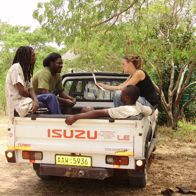-
 One of the things we’ve gotten used to in meetings at Kufunda is ants.
One of the things we’ve gotten used to in meetings at Kufunda is ants.Also millipedes.
Also sitting on rocks. Dogs. Five-year olds. The occasional bat. Weird little crabbish things that dash about randomly in a panic. Straw. Wind. A careening traffic of odors – of bodies, blossoms, life.
Tana’s last post was about reclaiming our meetings so that they become more vibrant and meaningful. One of the ways this happens at Kufunda is by making sure that all the meetings have cracks in them. They are not sealed off from other people, nature, or the regular life of the village.
One common meeting place is a circle of rocks just in front of the office. Here everything passes by or wanders in. Voices join voices – people talking about lunch preparation, shouts about who is catching the next ride into town or about why the internet isn’t working.
Another meeting place is called the dare (dah-ray). It is a beautiful round building, nestled in the boulders a little away from the main part of the village. You come to it after a surprising vaulted curve in the path. The walls of the building only go halfway up. Everything from outside feels inside too. Trees lean in. The big stones piled on top of each other frame whatever it is we are working on.
At the recent Powers of Place gathering at Kufunda, Glenna Gerard, one of the conveners, described place as a co-facilitator, not just a location or backdrop, but something that thinks and creates with us.
One of the ways that place seems to do this is by disturbing us. When place is very present, it jars us out of our normally narrow work focus. It reminds us that we are larger than these rooms. That whatever designs, problems, projects we’re working on are not small and abstract. They are dense, tissued. They breathe and sweat.
The intelligence of a meeting is increased when the context is part of it. Here at Kufunda it is hard to forget that. But how do we connect to this contextual intelligence in more traditional organizational environments where meeting spaces can be far-removed from nature and the hum of human interaction?
(Blog title from Leonard Cohen’s “Anthem”)
“That’s how the light gets in”




4 Responses and Counting...
Thank you for this! I love it and will share it and take inspiration from it for a series of conversations here in Montreal.
It reminds me so much of Kahlil Gibran’s chapter from The Prophet, On Houses:
Then a mason came forth and said, “Speak to us of Houses.”
And he answered and said:
Build of your imaginings a bower in the wilderness ere you build a house within the city walls.
For even as you have home-comings in your twilight, so has the wanderer in you, the ever distant and alone.
Your house is your larger body.
It grows in the sun and sleeps in the stillness of the night; and it is not dreamless. Does not your house dream? And dreaming, leave the city for grove or hilltop?
Would that I could gather your houses into my hand, and like a sower scatter them in forest and meadow.
Would the valleys were your streets, and the green paths your alleys, that you might seek one another through vineyards, and come with the fragrance of the earth in your garments.
But these things are not yet to be.
In their fear your forefathers gathered you too near together. And that fear shall endure a little longer. A little longer shall your city walls separate your hearths from your fields.
And tell me, people of Orphalese, what have you in these houses? And what is it you guard with fastened doors?
Have you peace, the quiet urge that reveals your power?
Have you remembrances, the glimmering arches that span the summits of the mind?
Have you beauty, that leads the heart from things fashioned of wood and stone to the holy mountain?
Tell me, have you these in your houses?
Or have you only comfort, and the lust for comfort, that stealthy thing that enters the house a guest, and becomes a host, and then a master?
Ay, and it becomes a tamer, and with hook and scourge makes puppets of your larger desires.
Though its hands are silken, its heart is of iron.
It lulls you to sleep only to stand by your bed and jeer at the dignity of the flesh.
It makes mock of your sound senses, and lays them in thistledown like fragile vessels.
Verily the lust for comfort murders the passion of the soul, and then walks grinning in the funeral.
But you, children of space, you restless in rest, you shall not be trapped nor tamed.
Your house shall be not an anchor but a mast.
It shall not be a glistening film that covers a wound, but an eyelid that guards the eye.
You shall not fold your wings that you may pass through doors, nor bend your heads that they strike not against a ceiling, nor fear to breathe lest walls should crack and fall down.
You shall not dwell in tombs made by the dead for the living.
And though of magnificence and splendor, your house shall not hold your secret nor shelter your longing.
For that which is boundless in you abides in the mansion of the sky, whose door is the morning mist, and whose windows are the songs and the silences of night.
Nice post, you two. I can’t help but think about those oh-so-rare moments in school when we went outside to hold our class. Of course, the teacher tried to pretend that s/he could ‘accomplish’ the exact same things outside as could be done inside. The result was complete failure. In retrospect, the opportunity was lost to redefine what could be accomplished by being outside on the lawn that could then add to the educational objectives. What you are demonstrating is that to actually benefit from a meeting (particularly if it’s in a space that is different from the regular) is to acknowledge the change and look for other ways of being successful.
P.S. I had the same experience at one of my workplaces. Needless to say, we didn’t do it very often.
Beautiful, Michelle. Maybe we could get that guy to write a couple of posts for us. Do you know if he’s busy? ;-).
Andrew, that’s a great comparison and a lovely reminder . . . . I think I’ve made that same mistake in my own teaching many times.
you said – “One of the ways that place seems to do this is by disturbing us…”
one thing i have learnt from my sojourns in nature, especially old-forests… connections to a place includes ‘repulsion’ (as opposite in direction to attraction, but without revulsion).
a place seems to speak to us and tell us we are not a match for each other. and that information is not written in stone… it could be a temporary truth of the ‘now’…
so, either that ‘disturbing’ is like a bottle shake, to re-arrange us… or… it tells us we are not a natural match right now. – like a cheetah in a thick jungle.